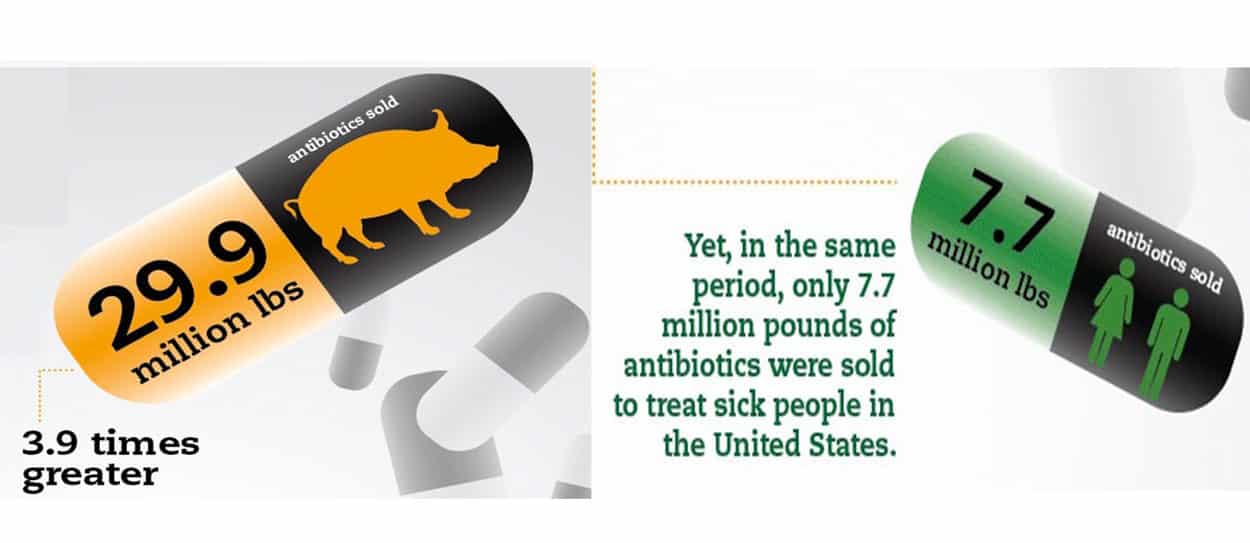When farm animals are fed antibiotics, they can develop antibiotic-resistant bacteria in their guts. Manure contamination of meat can then transfer these gut bacteria to humans. These bacteria can even spread to vegetarians, since drug-resistant bacteria in the animal feces can also spread to people through crops or the environment. Exhaust fans can blow MRSA superbugs straight out into the surrounding area from pig or poultry operations. This may explain why human MRSA infections in Europe have been tied to just living in a region with industrial pig production, whether or not people have direct contact with livestock. These findings may not just be limited to Europe.
European factory farms pale in comparison to what we have here in the U.S. From an article published in the Journal of the American Medical Association’s Internal Medicine: “proximity to swine manure application to crop fields and livestock operations was each associated with MRSA and skin and soft-tissue infections [in people in the U.S]. These findings contribute to the growing concern about the potential public health impacts of high-density livestock production.”
An article published in Lancet Infectious Diseases explains that, “achievements in modern medicine, such as surgery, the treatment of preterm babies, and cancer chemotherapy, which we today take for granted, would not be possible without access to effective treatment for bacterial infections. Within just a few years, we might be faced with dire setbacks, medically, socially, and economically, unless real and unprecedented global coordinated actions are immediately taken” to protect these wonder drugs. Therefore, the use of antibiotics just to promote the growth of farm animals to slaughter weights should be banned worldwide. Europe stopped feeding pigs and chickens tetracycline and penicillin to promote growth about 40 years ago, something the U.S. meat industry continues to do to this day.
The Pew Commission recently published a five year update on their landmark blue ribbon commission report on current agricultural practices that found “the present system of producing food animals in the United States presents an unacceptable level of risk to public health.” Their number one recommendation was to ban the non-therapeutic use of antibiotics, but agriculture lobbies are not going to give up the use of antibiotics without a fight (See Antibiotics: Agribusinesses’ Pound of Flesh).
In December 2013, the FDA released “Guidance for Industry,” their voluntary, non-binding recommendation for industry. They recommend antibiotics no longer be used to just fatten animals for slaughter, but emphasize that they are just that: toothless, non-legally enforceable suggestions. As mentioned in the Pew Commission report, “this voluntary approach has come under withering criticism from the public health and medical communities concerned about the increase in antibiotic-resistant bacterial pathogens.”
The USDA is even considering going backwards, eliminating the requirement to even test for Staph aureus at all in the Federal School Lunch Program. They understand that “school-aged children are considered a ‘sensitive population’, hence, more stringent requirements, including sampling plans, may be considered to help assure safety and public confidence. However, the cost of such programs must be weighed against the cost of buying the food needed to support the program.”
As one University of Iowa epidemiologist said, “although human health should take priority over farm animals, farmers will be reluctant to change until researchers can come up with safe and cost-effective practices to replace the use of antibiotics.” How much are antibiotics really saving the industry? The net bottom-line benefit from the use of antibiotic feed additives may only be about $0.25 per animal, which means eliminating the risky practice of feeding antibiotics by the ton to farm animals would raise the price of meat less than a penny per pound.
For those not familiar with MRSA, please see my past videos on the topic:
For more on antibiotic use on the farm, see:
- Lowering Dietary Antibiotic Intake
- More Antibiotics in White Meat or Dark Meat?
- Meat Mythcrushers
- Food Poisoning Bacteria Cross-Contamination
- Unsafe at Any Feed
- Zero Tolerance to Acceptable Risk
- Past the Age of Miracles: Facing a Post-Antibiotic Age
- Superbugs in Conventional vs. Organic Chicken
In health,
Michael Greger, M.D.
PS: If you haven’t yet, you can subscribe to my free videos here and watch my live year-in-review presentations Uprooting the Leading Causes of Death, More Than an Apple a Day, From Table to Able, and Food as Medicine.
